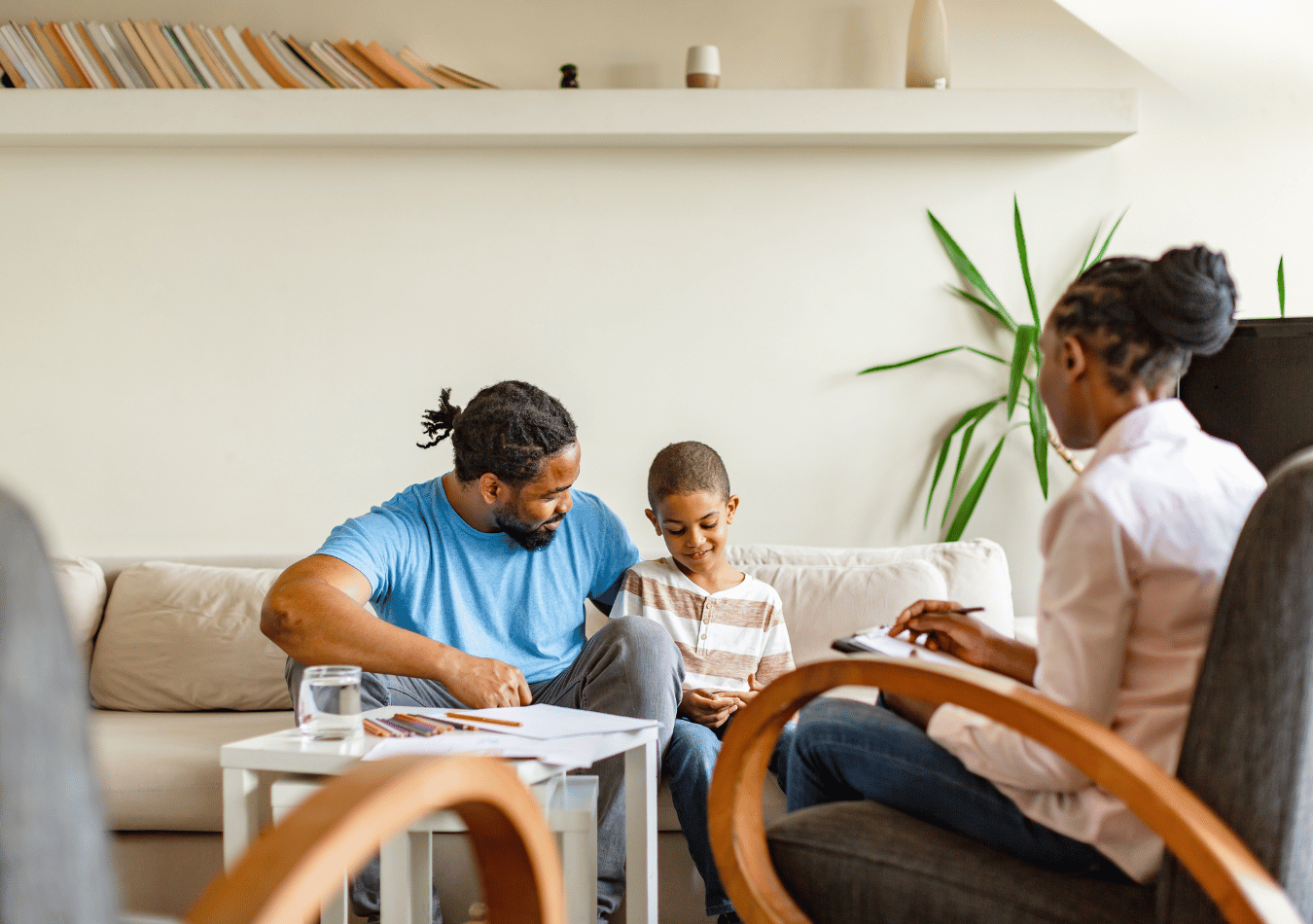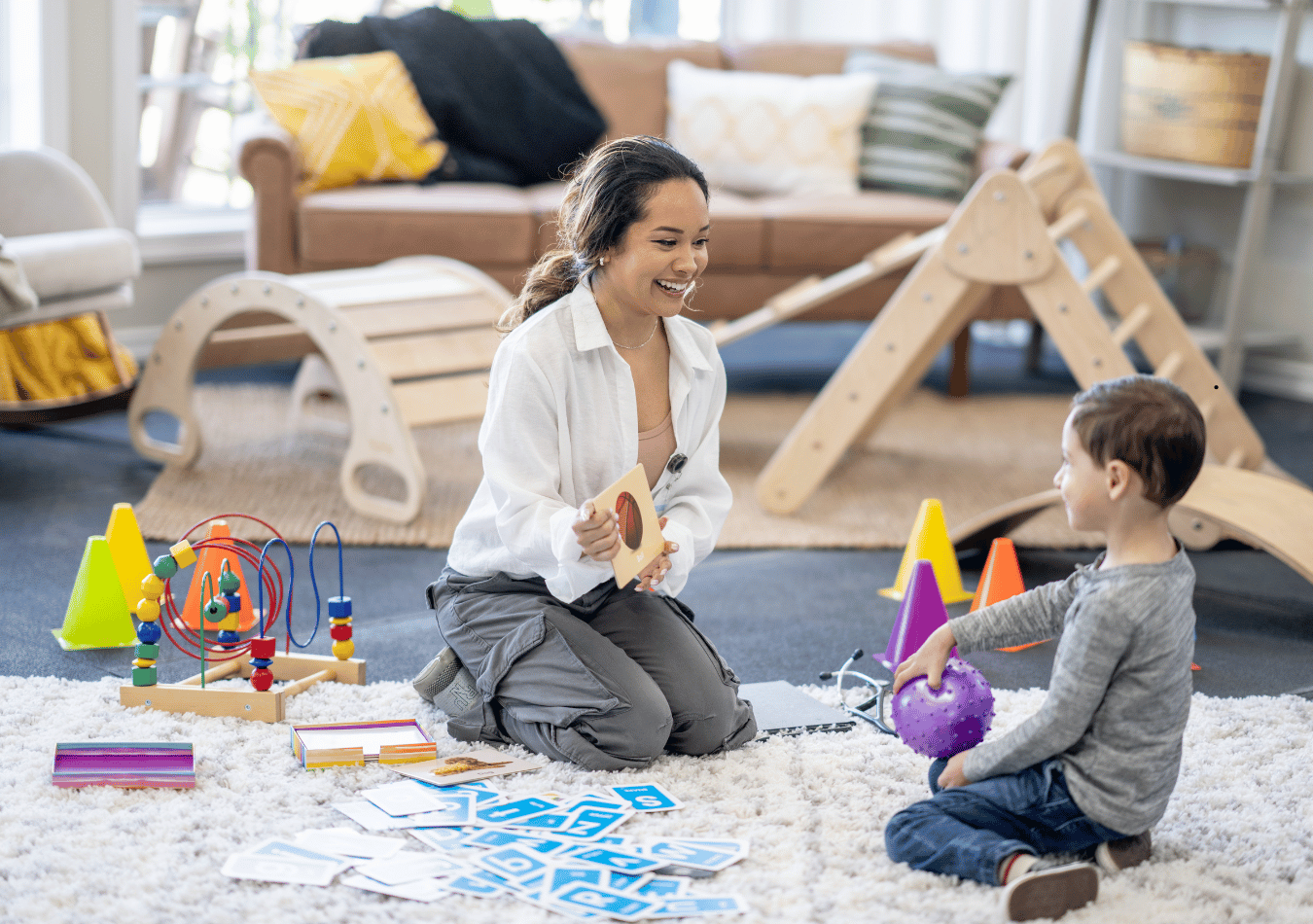At Love Play Grow, we believe in fostering a world where children blossom with confidence, build strong relationships, and navigate challenges with resilience. We know that expressing themselves can be a hurdle for young minds, and traditional talk therapy, while valuable, might not always be the most comfortable space for them.
That’s why our highly trained children’s therapists use a multifaceted approach.Through a comprehensive assessment, we delve deeper to understand the root cause of your child’s struggles. From here, we use a variety of therapeutic tools, each designed to address specific needs and empower your child’s inner potential.
We know how effective this approach can be because we’ve seen it firsthand with the children and families we’ve helped. However, we also recognize the desire to start helping your child at home today.
That’s why we’ve created this blog post. Here, we share some of our favorite counseling activities for kids so you support your child in exploring and expressing emotions from the comfort of home.
Let’s dive in!

Types of child therapy
Play therapy is a cornerstone of our approach at Love Play Grow. However, we recognize that every child’s needs are unique. We’ll explore some of the evidence-based therapeutic approaches that we use to help create a well-rounded therapy experience for your child.
Play therapy
Play therapy is a powerful tool that allows children to express themselves freely and process emotions through play. Our therapists use various play therapy techniques to help children develop social skills, communication skills, coping mechanisms, and emotional regulation. Play therapy can be used to address a wide range of concerns, including anxiety, depression, behavioral issues, low self-esteem, and social difficulties.
Creative art therapy
Creative art therapy utilizes artistic expression to help children explore their emotions, thoughts, and experiences. Through activities like painting, drawing, and sculpting, children can gain self-awareness, develop coping skills, and improve their emotional well-being. These creative interventions can be particularly helpful for children who are shy or withdrawn, as it allows them to communicate indirectly.
Sandtray therapy
Sandtray therapy provides a safe and creative space for children to express themselves symbolically. During a sandtray session, your child will choose miniature figurines and objects to create a scene in a tray filled with sand. The therapist will observe and ask open-ended questions to help your child explore the emotions and experiences represented in the sandtray creation. Sandtray therapy can be another valuable tool for children who have difficulty expressing themselves verbally.
Eye movement desensitization and reprocessing (EMDR)
EMDR is a psychotherapy approach that can be highly effective in helping children who have experienced trauma. During EMDR sessions, your child will follow a therapist’s hand movements with their eyes while recalling a disturbing memory. This process helps to reprocess the memory and reduce its emotional intensity. EMDR can be especially helpful for children who struggle to talk about their experiences but still show signs of emotional distress.
Cognitive behavioral therapy (CBT)
CBT helps children identify and challenge negative thought patterns that contribute to emotional and behavioral problems. Through CBT activities, your child will learn to recognize these thought patterns and develop healthier coping mechanisms. For example, a child who worries excessively might be introduced to coping strategies or engage in activities that challenge their negative predictions about situations.
Mindfulness
Mindfulness practices cultivate present-moment awareness and focus. By teaching children mindfulness techniques like meditation and deep breathing exercises, we can help you child accept difficult life changes, manage stress, and process emotions. Mindfulness can also help children improve their focus and concentration.
21 therapy activities for children that you can try at home today
It’s important to note that counseling activities are most effective when provided by a licensed mental health professional in the context of therapy sessions. However, some of these activities can be adapted for use at home with your child and may be a helpful supplement to your work with one of our play therapists.
Here are examples of some of our favorite child therapy activities, categorized by the therapeutic approach that they draw from.
Play therapy activities
1. Feeling faces
Create a set of flashcards or a poster board with different facial expressions. Label each emotion (happy, sad, angry, scared, etc.) Have your child point to the face that matches how they’re feeling or ask them to draw their own face to express their emotions.
2. Play-Doh volcano
Create a volcano out of play-doh and baking soda. Then, mix vinegar and dish soap in a cup. Together, erupt the volcano by pouring the vinegar mixture inside. Talk about healthy ways to express anger, like using “I” statements or taking deep breaths.
3. Worry monsters
Provide your child with a box, old socks, felt scraps, googly eyes, and other craft supplies. Help them design a worry monster. As they create the monster, encourage them to talk about their worries and fears. Once the monster is complete, have your child imagine the monster “eating” their worries.
4. Puppet show
Make puppets using paper bags, socks, or craft sticks and decorate them together. Put on a puppet show together and use the puppets to act out social situations, like making a new friend, asking a family member for help, or dealing with a bully.
5. Board games
Choose age-appropriate board games that involve turn-taking and cooperation. While playing, emphasize the importance of following the rules, taking turns patiently, and congratulating the winner.
6. Building blocks
Provide your child with blocks and encourage them to build a structure together. Talk about teamwork and communication as you work together on the project. Take turns assigning roles and following each other’s lead.
7. Obstacle course
Use pillows, blankets, chairs, and other household items to design an obstacle course in your living room. Time yourselves as you complete the obstacle course and encourage creative problem-solving to overcome the challenges.
8. Storytelling
Start a story together and take turns adding sentences or paragraphs. Focus on creating a cause-and-effect chain in the story, where one event leads to another. This play therapy activity helps children develop logical thinking and problem-solving skills.
9. Maze games
Print out maze activities or use online maze generators to find mazes appropriate for your child’s age and skill level. Work together to solve the maze, discussing different strategies and encouraging critical thinking.
Cognitive behavioral therapy (CBT) activities
10. Thought identification
Help your child identify negative thought patterns by keeping a journal. Each day, have them write down a situation that made them feel upset or anxious. Then, ask them to identify the thoughts they had in that moment.
11. Cognitive restructuring
Once your child identifies a negative thought, challenge it together. Ask questions like “Is this thought always true?” or “What’s another way to look at this situation?” Help them develop more positive and realistic thoughts to replace the negative ones.
12. Reward systems
Create a reward chart together and identify desired behaviors or coping mechanisms you want to encourage. Each time your child demonstrates the desired behavior, they can earn a sticker or a small reward on the chart. Once the chart is full, celebrate by doing a fun activity together.
Mindfulness activities
13. Deep breathing exercises
There are many deep breathing techniques you can practice with your child. Try belly breathing: have your child place a hand on their belly and take slow, deep breaths through their nose, feeling their belly inflate. Hold for a count of two, then slowly exhale through pursed lips.
14. Body scan meditation
Guide your child to lie down comfortably in a quiet space. Ask them to close their eyes and focus on their breath. Then, gently guide them to bring their awareness to different parts of their body, one at a time. Notice any physical sensations without judgment.
15. Mindful movement
Practice gentle yoga poses or stretches together. Focus on the breath and body sensations as you move through each pose. You can also find mindful movement videos online specifically designed for children.
Sandtray therapy activities
16. World building
Provide your child with a small sand tray or bin filled with sand and a collection of miniature objects like figurines, toy animals, vehicles, and natural materials. Let them create a world inside the sandtray using the objects. As they play, ask open-ended questions like “What is happening in your world?” or “Tell me a story about what you created.” This will help you understand their emotional state and any symbolic messages they might be expressing through the sand and objects.
17. Storytelling with sand
Once your child has created a sandtray scene, encourage them to tell a story about it. This can help them explore their emotions and experiences in a creative and indirect way. You can ask them questions like “Who are the characters in your story?” or “What is happening in the story?”
18. Guided sandplay
If you’d like to target a specific challenge your child is facing, you can introduce a gentle prompt or theme for the sandtray activity. For example, if your child is anxious about starting a new school year, you could provide objects related to school, such as miniature desks, backpacks, or teachers. Ask them to create a scene that shows what school might be like for them. Observe their creations and use open-ended questions to help them explore their anxieties and develop coping mechanisms.
Creative art therapy activities
19. Emotional art exploration
Gather various art materials like paints, crayons, markers, clay, or play-doh. Set aside some time for your child to create freely, without judgment or expectation. Encourage them to use colors and techniques that represent how they’re feeling. Afterward, you can talk to them about their artwork and explore the emotions they might have expressed.
20. Mandala making
Provide your child with coloring sheets or printables featuring mandalas, which are circular patterns with intricate designs. Mandala coloring can be a calming and focusing activity. Encourage them to use different colors and patterns to fill in the mandala. Talk about the feeling of peace and focus they might experience while coloring.
21. Art journaling
Give your child a dedicated art journal or sketchbook. Encourage them to use it as a space to express themselves freely through drawings, collages, or mixed media. They can use their art journal to document their emotions, experiences, or dreams. You can also suggest prompts to get them started, such as “Draw a picture of your happy place” or “Create a collage that represents your favorite things.”

Final thoughts on child therapy activities
We recognize that a well-rounded approach is often necessary to address a child’s unique needs. The therapeutic approaches explored here, including play therapy, cognitive behavioral therapy, sandtray therapy, creative art therapy, and mindfulness, can be used individually or combined to help your little one thrive.
In therapy, we’ll work with your child, individual family members, and even your family as a whole to help you with challenges like:
- Anxiety and depression
- Managing negative emotions
- Attention challenges
- Family dynamics
- Social skills
- Behavioral issues
- Life transitions
…and more.
If you’re concerned about your child’s emotional well-being, don’t hesitate to seek professional help. Our team of experienced therapists at Love Play Grow can work with your child and family members to develop a plan that promotes emotional growth and helps your child thrive. Contact us today for a consultation and let’s work together to empower your child on their journey to a brighter future.










